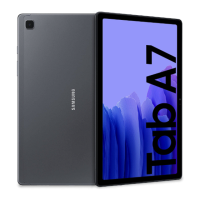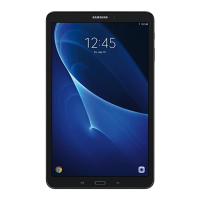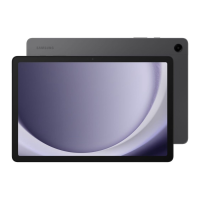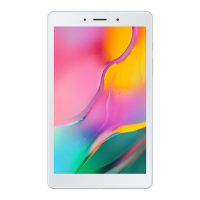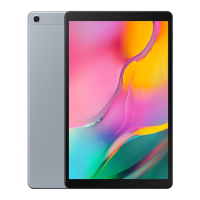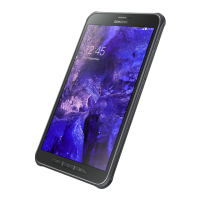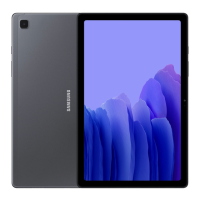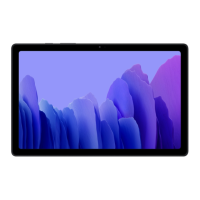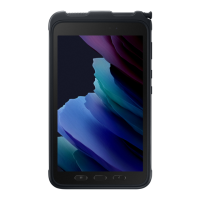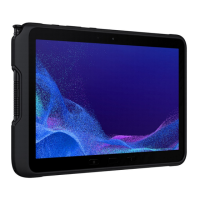Do you have a question about the Samsung Galaxy Tab A8 and is the answer not in the manual?
Instructions for initial device setup, including charging the battery and connecting accessories.
Guidance on powering on, navigating, and performing basic operations on the device.
Explains touch gestures like tap, swipe, drag, and zoom for interacting with the screen.
Details on using and customizing navigation buttons or gestures for device control.
Guide to customizing the home screen with app icons, widgets, and wallpapers.
Instructions for configuring facial recognition for device unlocking and account access.
Information on seamless device interaction across Samsung ecosystem, like call/text forwarding.
Guides on using split-screen multitasking and accessing Edge panels for quick functions.
Covers entering text via the on-screen keyboard and voice input.
How to navigate the camera interface, focus, adjust brightness, and use shooting modes.
Guide to recording videos, taking pictures during recording, and editing clips.
Managing photos and videos, including viewing, sorting into albums, and basic editing.
Using features like transform, filters, tone, stickers, and text to enhance pictures.
Instructions for sharing pictures/videos and deleting unwanted media files.
Methods for capturing screenshots and recording screen activity.
Covers uninstalling, searching, sorting apps, and organizing them into folders.
Overview of essential Samsung apps like Galaxy Store, Samsung Health, and Voice Recorder.
Descriptions of key Google apps such as Chrome, Drive, Gmail, Maps, and YouTube.
Information on pre-installed Microsoft apps like Outlook, Office, and OneDrive.
Methods to find and open device settings, including a search function.
Configuring Wi-Fi, Bluetooth, mobile data, and other network connections.
Adjusting sound modes, volume levels, ringtones, notification sounds, and system sounds.
Managing app alerts, customizing notification styles, and enabling Do Not Disturb mode.
Customizing screen brightness, dark mode, font size, screen zoom, and timeout.
Setting up screen locks, biometric security, Google Play Protect, and Find My Mobile.
Adding, managing, and removing user and cloud accounts like Google and Samsung accounts.
Optimizing performance, managing battery, storage, memory, and device protection.
Features for users with visual, auditory, or dexterity impairments, including TalkBack and text display.
Accessing help, labs, quick share, legal notices, and contact information.
| HD type | WXGA |
|---|---|
| Panel type | TFT |
| LED backlight | Yes |
| Display diagonal | 8 \ |
| Touch technology | Multi-touch |
| Touchscreen type | Capacitive |
| Display resolution | 1280 x 800 pixels |
| Native aspect ratio | 16:10 |
| Processor cores | 4 |
| Processor family | - |
| Processor frequency | 2 GHz |
| Platform | Android |
| Operating system installed | Android 9.0 |
| Internal memory | 2 GB |
| User memory | 21.2 GB |
| Storage media | Flash |
| Compatible memory cards | MicroSD (TransFlash) |
| Maximum memory card size | 512 GB |
| Internal storage capacity | 32 GB |
| Rear camera type | Single camera |
| Video capturing speed | 30 fps |
| Video recording modes | 1080p |
| Maximum video resolution | 1920 x 1080 pixels |
| Resolution at capture speed | 1920x1080@30fps |
| Rear camera resolution (numeric) | 8 MP |
| Front camera resolution (numeric) | 2 MP |
| Battery capacity | 5100 mAh |
| Wi-Fi standards | 802.11a, 802.11b, 802.11g, Wi-Fi 4 (802.11n) |
| Bluetooth version | 4.2 |
| Top Wi-Fi standard | Wi-Fi 4 (802.11n) |
| HDMI ports quantity | 0 |
| Headphone connectivity | 3.5 mm |
| Micro-USB 2.0 ports quantity | 1 |
| Audio formats supported | 3GA, AAC, AMR, AWB, FLAC, IMY, M4A, MID, MIDI, MP3, MXMF, OGG, OTA, RTTTL, RTX, WAV, WMA, XMF |
| Video formats supported | 3GP, ASF, AVI, FLV, M4V, MKV, MP4, WEBM, WMV |
| Device type | Mobile tablet |
| Form factor | Slate |
| Product color | Black |
| Depth | 8 mm |
|---|---|
| Width | 124.4 mm |
| Height | 210 mm |
| Weight | 347 g |

